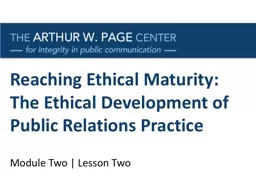

Module Two Lesson Two Lesson Two Principles Lesson Overview Ethical development in public relations Public relations models Press agentrypublicity Public information Twoway asymmetrical ID: 621956
Download Presentation The PPT/PDF document "Reaching Ethical Maturity: The Ethical D..." is the property of its rightful owner. Permission is granted to download and print the materials on this web site for personal, non-commercial use only, and to display it on your personal computer provided you do not modify the materials and that you retain all copyright notices contained in the materials. By downloading content from our website, you accept the terms of this agreement.
Slide1
Reaching Ethical Maturity: The Ethical Development of Public Relations Practice
Module Two | Lesson TwoSlide2
Lesson Two | Principles
Lesson Overview
Ethical development in public relations
Public relations models:
Press agentry/publicity
Public information
Two-way asymmetrical
Two-way symmetricalTARESPillars of public relations ethicsSlide3
Lesson Two | Principles
Ethical Progression of
Moral Obligations
Themselves
Clients
Organizations/employers
Profession/colleagues
SocietySlide4
Lesson Two | Principles
Press Agentry Model
Publicity
Focus on self-interest
Teleology orientation
Outcome more important than the processSlide5
Lesson Two | Principles
Discussion Question
Explain how the press agentry model exemplifies a teleological approach. What are the ethical advantages/ disadvantages of this practice of
public relations?Slide6
Lesson Two | Principles
Public Information Model
“Journalist in residence”
Focus on truthful and accurate information
Deontology orientation
Professional codes of ethics guide behaviorSlide7
Lesson Two | Principles
Discussion Question
How does the application of the PRSA code of ethics represent a deontological approach in the public information model of public relations?Slide8
Lesson Two | Principles
Two-Way Asymmetrical Model
Persuasive communication
Feedback loop offers an “other” ethical perspective
Teleology orientation
Risks/Benefits assessment to maximize benefit and minimize harmSlide9
Lesson Two | Principles
Discussion Question
How does the two-way asymmetrical public relations model offer an “other” perspective absent from the two lesser models? Why is this perspective important to ethical development?Slide10
Lesson Two | Principles
Two-Way Symmetrical Model
Mutually beneficial relationships
Dialogue is central
Deontology orientation
Kant’s
universal
lawHabermas’ theory of ethical discourseBroader societal focusSlide11
Lesson Two | Principles
Discussion Question
How does Habermas’ theory of ethical discourse support the ethical practice of two-way symmetrical
public relations?Slide12
Lesson Two | Principles
Five Pillars of Public Relations Ethics
Veracity – to tell the truth
Non-maleficence – to do no harm
Beneficence – to do good
Confidentiality – to respect privacy
Fairness – to be fair and socially responsibleSlide13
Lesson Two | Principles
Discussion Question
How might the pillars of ethical public relations guide the ethical behavior of public relations professionals?